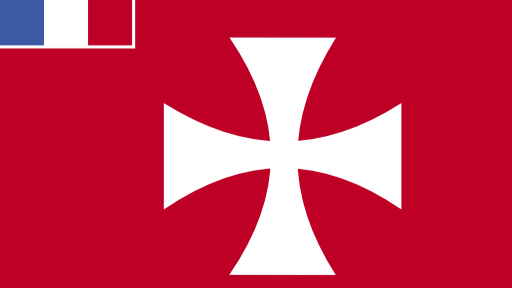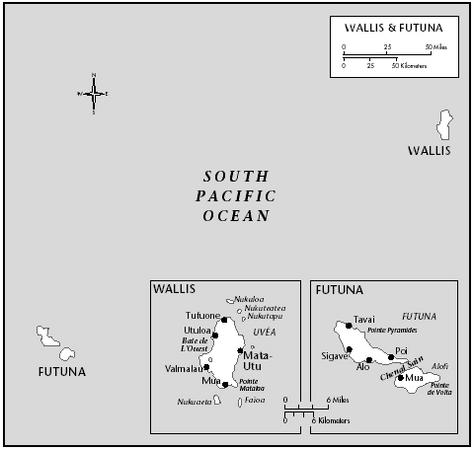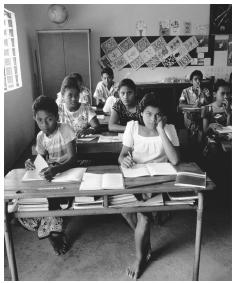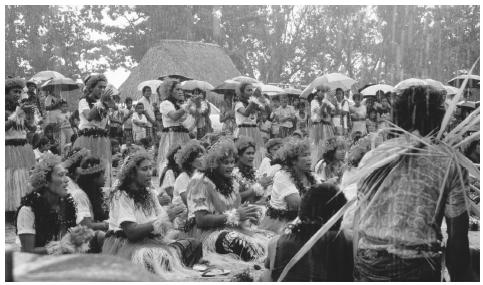Culture of Wallis and Futuna

Culture Name
Wallisian and Futunan
Orientation
Identification. Wallis is named after the eighteenth century English explorer Samuel Wallis. Some people call the island East 'Uvea to distinguish it from an island off the east coast of New Caledonia, known as West 'Uvea, which was settled two hundred years ago by people from East 'Uvea. The population is of Tongan ancestry. Futuna was called the Hoorn Islands by Dutch explorers. Futuna includes the nearby uninhabited island of Alofi.
Location and Geography. The island of Wallis lies in the central Pacific. It is a raised reef, mainly limestone, with an area of ninety-six square miles (250 square kilometers). It is surrounded by a wide lagoon with many small islets. There are no rivers but several lakes in the interior plateau. Better soil is found on the coastal rim, where large trees and crops are cultivated. The villages are in this coastal region, predominantly on the eastern side. The western side is uninhabited; several of the larger islets are inhabited. The lagoon is shallow, and barely navigable. The island is divided into three districts. Mu'a, the most populous; Hahake; and Hihifo. The main town where government offices and the hospital are located is Mata'utu in Hahake in the central district.
Futuna lies one hundred miles southwest of Wallis. Futuna and Alofi are volcanic islands. Futuna is twenty-five square miles (64 square kilometers), and Alofi is eleven square miles (28 square kilometers) in area. A narrow reef encircles both islands, but there is no lagoon. People cultivate the hillsides and use the banks of streams to grow taro. The island is divided by several major rivers, and the population lives in the southern coastal zone. The island is divided into two kingdoms: Sigave in the west and Alo in the east. Leava in Sigave is the main town and port.
Demography. The population of Wallis was 8973 in 1990, and in 1995 was estimated at 9,500. The population of Futuna was estimated at 5,000 in 1995. Similar numbers of Wallisians and Futunans live in New Caledonia. On Wallis, the population lives on the eastern side of the island in communities near a Catholic church. Europeans, mainly French administrators and teachers, account for about 3 percent of the total population.
Linguistic Affiliation. The 'Uvean language is a Western Polynesian language closely related to Tongan. Wallisians use 'Uvean as their everyday language. All school-age and older persons also speak French, the language of the administration. A few people also speak English. The Futunan language is of Samoic origin. It is the language of everyday life, though French is used on official occasions and is taught in schools.
Symbolism. The kava bowl and tapa cloth are important symbols of both cultures. Kava is drunk both ritually and secularly in Futuna. The kava bowl is used to honor chiefs and the existing hierarchy. Tapa cloth is made by women for exchange at rituals that draw extended families together. It is symbolic of women's wealth, along with specially scented oil. Tapa is also sold to tourists. Food gifts are symbols of welcome and good will. The malae , or meeting ground, is a place where people gather to honor their chiefs (kings in Futuna). The Lomipeau canoe represents the ties between Wallis/'Uvea and the early maritime empire of Tonga of four hundred years ago. It also symbolizes the strong seagoing tradition of these people, particularly their journeys to Tonga, Samoa, and other islands.
History and Ethnic Relations
Emergence of the Nation. Wallis and Futuna are treated as a single overseas territory of France. Wallis emerged from the Early Tongan Maritime Empire in the l500s. Before that time it was part of

Wallis and Futuna
Tonga and shared its language and customs. Those ties were weakened in the mid-nineteenth century when the French banned overseas voyaging. Futuna has close cultural ties with Samoa and Rotuma. With the arrival of the Catholic mission in the l830s, a long history of warfare ended.
In l844, France was invited to protect the people of Wallis and Futuna under the rule of the Catholic Church. France took over political management in l888 at the insistence of Lavelua (Queen) Amelia, who wanted a French doctor to become the administrator. The French navy provided a series of administrators. The result was a tripartite administration of Wallis and Futuna. The Lavelua along with the Tui Sigave and Tuiagaifo of Alo for Futuna, all chiefly families, represented the traditional leadership; the French naval doctors, were the colonial administrators; and the bishop of the Catholic Church also exercised administrative powers.
National Identity. Wallis is the dominant partner because of its larger population and the French colonial administration in Mata'utu. Despite intermarriages, Wallisians and Futunans refer to themselves as separate cultural entities.
Ethnic Relations. There is a small French community in Wallis that consists mainly of administrators and secondary teachers. There are few English speakers and no Chinese community.
Urbanism, Architecture, and the Use of Space
Wallis is predominantly a rural community. All the villages are linked by road to Mata'utu. The villages surround a Catholic church where people gather at large family occasions. A program to teach building skills has led to the construction of numerous churches built with expensive imported materials.
Houses are substantial, built mainly of concrete with corrugated iron roofs. A few houses of local materials, with pandanus thatch sides and thatched roofs, still exist. Houses are furnished to varying degrees, and people prefer to sit on the floor. Some cooking is done outdoors. Toilet facilities are attached to the home in newer houses. Houses are scattered have one or two acres of land that is used to grow subsistence crops. A house site may consist of four or five houses for the extended family.
Futunan houses follow the Samoan fale style. The sleeping house is open-sided with a thatched roof and thatched blinds that can be let down in bad weather. There may be a concrete floor and a low wall to keep the pigs out. Cooking is done in a cook house behind the sleeping house or in an earth oven in the bush. Water and electricity were installed in 1990, though few families can afford electricity.
Wallis has an urban space that contains government buildings and a shopping area. Futuna consists of a string of villages along the southern coast, of which Leava is the main center. Each village has a small shop.
Food and Economy
Food in Daily Life. Family households rely on taro, yams, and sweet potatoes. Villages on Wallis near the lagoon eat fish. If no man in the family is available, women comb the lagoon for crustaceans. Pigs and chickens are raised mainly for celebratory occasions.
Families eat twice a day. Bread and coffee are the mainstays of breakfast. The evening meal consists of taro or yam and fish (on Wallis) and sometimes frozen chicken or corned beef. Tea is the most common beverage.
Food Customs at Ceremonial Occasions. Every family contributes food on public occasions. Pork and turtle are feast foods, with chicken also being reserved for special occasions. Alcohol is an expected part of public feasting on Wallis, and kava is drunk by Futunan men.
Basic Economy. Both Wallis and Futuna have a subsistence-based economy. The land produces taro, yams, sweet potatoes, cassava, and breadfruit. There are no sales of local foods, except to foreigners. The nuns teach cooking and how to use new foods.
On Wallis working for the government and teaching are the main sources of employment. Overseas remittances from family members in New Caledonia contribute to the basic economy. Young men serving in the French military also send or bring goods home. Futunan families farm the hillsides inland and also maintain a small garden in which they grow the kava plant and bananas for daily use.
Land Tenure and Property. Two types of land are distinguished; bush land and house land. Families "possess" some lands that link them to a pule and ultimately to the traditional chief. There is also land for use by members of the village. Family land rights are passed to both sons and daughters, but males bear the major responsibility for keeping the land productive. All family members are expected to work on the family land.
Commercial Activities. There are minimal commercial activities. One or two importers, French by nationality, serve the purchasing requirements of the community, namely running one super market, and selling to the small stores in each village. There are no exports, other than an occasional shipment of handicrafts to New Caledonia. Electricity is provided by hydro-generation on Futuna, run by a French-based company.
Major Industries. Tourism is considered essential to the economy but is dependent on irregular air links. There are two small hotels and three or four restaurants on Wallis. There are no hotels on Futuna.
Trade. There are no significant exports except foods to family members in New Caledonia. Imports include hardware, building materials, vehicles, electrical wiring, and appliances. These exports come from France via New Caledonia, Australia or New Zealand. There is one supermarket, and each village has a small store run by a local family. Women make tapa for sale in New Caledonia.
A boy and his dog run past thatch roof huts on Futuna Island, Wallis and Futuna. These huts follow the general style of Futuna homes.
Division of Labor. Men and women on Wallis work together on family land. Men cultivate steep lands on Futuna, while the women remain in the village, making tapa and other handicrafts, and caring for children. Most government jobs are held by men, but women predominate in the education sector. Women produce most of the handicrafts sold in New Caledonia. Men are more prominent than women in political affairs.
Social Stratification
Classes and Castes. Traditional hierarchies exist alongside stratification by income. Classes are perhaps more pronounced on Futuna. In Wallis, the traditional hierarchy persists, with the Lavelua at the apex and the general populace referred to as commoners. A distinction exists between families with and without cash income. Remittances from family members overseas also distinguish families. The Catholic Church is the largest landowner. Families that have produced a priest or nun have a high status.
Symbols of Social Stratification. Education levels are not important markers. New Caledonia has been the sole source of tertiary education until a two year post-secondary program opened up in l990.
Symbols of difference include a car or truck, a large house, furniture, access to electricity, and knowledge of life in New Caledonia. Gifts to the church are important indicators of status.
Political Life
Government. Wallis is run jointly with Futuna as a territory of the French government. The administrator represents the French republic and heads the cabinet, which consists of the three kings and three appointed members. An operational staff of government advisors operate on a budget supplied almost entirely by France. Wallis and Futuna together elect one representative to the French Senate.
The second form of local government is an elected body, the Territorial National Assembly which consists of an elected leader, and a body of elected assemblymen. This body debates finances and the issue of independence.
Leadership and Political Officials. The Lavelua, Tui Sigave, and Tuiagaifo rule their geographic areas. Each is assisted by district councillors. Their area of governance includes traditional access to labor as needed and welcoming visiting dignitaries.

Each village has a primary school.
They are the controlling authority in people's everyday lives and issue passports.
Social Problems and Control. Justice is administered by the prefect under French laws. The Lavelua and the two Futunan Tui, together with the Territorial Assembly, deal with local concerns. There is a small local police force.
Military Activity. All young men serve two years in the French military when they reach eighteen years of age.
Social Welfare and Change Programs
Welfare is the concern of families and falls under the traditional system of local government. France funds the hospital and the medical staff as well as many secondary schools and public works. A minimal welfare system is supported by the French. A small pension is available to those over age sixty, but there are few other means of support.
Nongovernmental Organizations and Other Associations
Trade unions have been active as workers, particularly teachers, seek better conditions. Catholic organizations include parents' groups associated with schools and a women's organization. There are links to other Catholic communities in the Pacific. A small group of health educators is supported by hospital administrators.
Gender Roles and Statuses
Division of Labor by Gender. Men and women work together in the fields. Work in the home is shared among the sisters and wives of brothers, so that mothering is a joint activity. Often Grandmothers are the care takers during the day if the women of the household are employed or are drawn away from the village by church activities. Men cook outdoors, while women cook indoors.
The Relative Status of Women and Men. Few women run for public office, but many women hold senior posts in government and in the community.
Women's status as sisters gives them higher rank than their brothers within the family. Oldest sisters in particular are honored, but as wives, however, they are expected to be subservient to their husbands.
Marriage, Family and Kinship
Marriage. Marriages are controlled by the family and formalized by the church. Missionaries once raised young boys and girls apart from their families and then arranged their marriages. Today young people meet in high school, and families approve or disapprove of the friendship. Cohabitation occurs but is not approved of by the family or the church. Illegitimate children are likely to be raised by aunts and grandmothers.
Domestic Unit. An extended family household is likely to consist of several houses linked by brothers and sisters and their spouses. Households change in size as young people and their children go to New Caledonia, leaving one or two children to look after the parents. When a young couple marry, they join the household of one of their families. It is rare for a new house to be built. The household usually is headed by the father or the oldest son, though occasionally the oldest sister takes this role. The extended family is the basic unit of interaction. Food and other gifts are exchanged, and children move freely between members of the extended family. A funeral draws the extended family together.
Kin Groups. Kin groups are synonymous with the extended family. Close ties are maintained despite

A festival on Futuna Island. The population of Futuna is approximately 5,000 people.
separation over distance, such as Noumea, France, or Futuna. Kinship is traced bilaterally, with both sons and daughters inheriting rights to the land, and membership of the kinship group. One son and one daughter are expected to look after the parents, including siblings of their parents. Strong kin ties between brothers and sisters hold the extended family together. Kin terms for brother and sister also apply to cousins. Funerals are major occasions when kin make every effort to travel from Noumea or France to honor a departed relative. Similarly, kin on Wallis and Futuna will endeavor to travel to Noumea for funerals of close kin.
Socialization
Infant Care. Infants are welcomed as an addition to the extended family. They are cared for by a number of relatives, both old and young. Sisters and aunties look after the infant's every need, so it is rare to hear a child crying. They attend church along with the family. An infant is weaned at about one year of age by an "auntie."
Child Rearing and Education. Children are raised and nurtured in an extended network of kin and are wanted and loved. They sleep alongside adults and accompany adults to the fields and to social events. Children who cry are quickly attended to.
Each village has a primary school run by the state. Primary education is much desired by parents, but classes are large and attendance is irregular because children, usually girls, are expected to meet home commitments as well as get an education.
Higher Education. Higher education is available in New Caledonia, France, and Australia, but graduates have difficulty finding jobs and adjusting to life back home. A two-year post secondary program was established in the islands in 1990.
Etiquette
Respect for elders and generosity are the core principles. Oldest sisters are honored and respected. Elders hold authority in the family, and brothers are expected to look after their sisters and guard their virginity. Men and women socialize in separate groups. Children are expected to sit quietly through church or a meeting; if they become restless, they are taken outside by a young sibling.
Religion
Religious Beliefs. The Catholic Church has been dominant on both islands for over 160 years. Villages are built around churches, which are maintained by the community.
Religious Practitioners. Catholic priests are the church leaders, with one serving several villages in a contiguous area. Nuns are also very active serving the Catholic community, particularly as teachers, but also in a wider caring role. The Bishop of Wallis and Futuna is a leading authority figure and still plays an important role in island politics.
Rituals and Holy Places. The original Catholic settlement at Lano in Hahake is still the center of Catholic society on both islands. Until about 1910, a secondary school trained future priests and nuns. Catholic feast days and holy days and first communions are part of the annual cycle of rituals. The beatification of Father Chanel in 1889 has made the basilica at Poi a special symbol of the Catholic religion. The installation of a new Lavelua or a new Tui Sigave or Tui Asoa is likely to involve a kava ceremony.
Death and the Afterlife. Funerals are major extended family events that draw together mourners from Wallis and those who can afford to return from New Caledonia.
Medicine and Health Care
Traditional medicine is practiced mainly by women, who use massage with local oils, potions made from local vegetable materials, and insertions of local plant materials into the appropriate orifices. Pregnancies are still treated largely by local health practitioners.
Major villages each have a small clinic with a visiting nurse several times a week. Serious cases are referred to the central hospital on Wallis. Less serious cases on Futuna are treated in a small hospital. Victims of road accidents must be airlifted to New Caledonia or Australia.
The Arts and Humanities
Support for the Arts. The church is an outlet for sales on Wallis and in Noumea. Men who carve sell their work in New Caledonia.
Literature. Literature has been poorly developed with few attempts to record myths and legends, or history locally. This is changing as tertiary education becomes available to Wallisians and Futunans.
Graphic Arts. Designs on siapo and tapa are a major art form for Wallisian and Futunan women, who use a template carved out and then applied to the beaten barkcloth. Both local and purchased dyes are used along with the traditional brown and black. Woven mats, often fringed with brightly colored wool, are used as gifts at the funerals of relatives.
Performance Arts. Participation in the Pacific Arts Festivals is a high point of community involvement. Dances are revived and composed to represent the unique features of the Wallisian and Futunan cultures. The South Pacific Games are another arena in which residents compete.
The State of the Physical and Social Sciences
The sciences are poorly developed. Government officials from France bring ideas but the absence of any tertiary training center has necessitated Wallisians and Futunans to travel overseas to gain western type knowledge of the sciences. A two year college that opened in 1991 will begin to change this.
Bibliography
Bibliographie, Phonographie, Filmographie et Museographie des iles Wallis et Futuna , 1976.
Burrows, Edwin. Ethnology of Futuna , 1936.
Connell, John. Migrations, Emploi et Developpement dans le Pacifique Sud , 1985.
Godard, P. Wallis et Futuna, 1976.
Kirch, Patrick. "Cultural Adaptation and Ecology in West Polynesia: An Ethnoarcheological Study." Ph.D. dissertation, Yale University, 1975.
Manuaud, S. Futuna, Ethnologie et Actualite, 1983.
Mayer, Raymond. Deux Cent Legendes de Wallis et Futuna, 1971.
Pollock, Nancy J. "Doctor Administrators on Wallis and Futuna." Journal of Pacific History 25 (1): 47–67, 1990.
Poncet, Monsignor. Histoire de l'Ile Wallis, le Protectorat Francais, 1972.
Rensch, Karl, ed. Tikisionalio Fakafutuna-Fakafalani, 1986.
Roux, J-C. "Migration and Change in Wallisian Society" In R. T. Shand, ed., The Island States of the Pacific and Indian Oceans.
Tikisionalio Fakauvea-Fakafalani, 1984.
Viala, M. "Les Iles Wallis et Horn." Bulletin de la Societe Neufchateloise de Geographie, vol. xxviii 1919.
